 Panorama of the Torridon skyline (taken by David Webster on a guided walking holiday with Scot Mountain Holidays
Panorama of the Torridon skyline (taken by David Webster on a guided walking holiday with Scot Mountain HolidaysAre you thinking about going a walking holiday in Scotland? You’re probably feeling a bit overwhelmed by the choice of options available to you. Of course, you might be influenced by images you’ve seen on social media. You’ve probably heard about Skye – the Old Man of Storr, the Quirang, the Cuillins. You’re toying with the idea of spending some time there. But Skye is suffering from the volume of tourists who are now adding it to their tour of Scotland.
An alternative is to consider one of the places along the North Coast 500, which is the new buzz route to take in Scotland. One of the best hiking spots along the route, where you can easily find walks to keep you happy for a whole week’s holiday is Torridon.
Torridon is an area of outstanding natural beauty situated around the sea lochs of Torridon & Shieldaig and inland to Kinlochewe. Its combination of rock and water, changing seasons and moods make this an awe-inspiring place to visit
“There are records that show that Queen Victoria loved to travel the road between Torridon and Diabaig in the late nineteenth century. Accompanied by John Brown, amongst others, she described this area as a fine and wild uncivilised spot, like the end of the world, as she wrote in her diary, and she noted that “hardly anyone ever comes here”.” From Steve Carter’s historical perspective of Torridon and Sheildaig
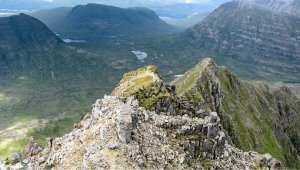 The spectacular sandstone peaks of Torridon, over 2500 million years old (taken by Jim Smith on our Classic Torridon itinerary in 2008)
The spectacular sandstone peaks of Torridon, over 2500 million years old (taken by Jim Smith on our Classic Torridon itinerary in 2008)
There’s the Torridon Inn of course but if you have your own transport and are prepared to put in a little more effort there is a delightful wee place to eat in Diabaig called Gille Brighde This is where we choose to go on the guided Classic Torridon walking holiday. If you’re prepared to travel a wee bit further or have the option of doing a linear walk you could also try the Applecross Inn, which features in our 6 pub walks blog
Some of the peaks in Torridon are quite challenging and require a small amount of scrambling. Hiring a guide will mean that you will be as safe as possible and he or she will be able to keep you on track timewise so the day does not end up being an epic venture out. Your guide will also be able to interpret the weather forecast so as to make the best of the prevailing weather conditions. For more reasons on why it is beneficial to you to hire a guide read our blog
For other guided hiking options go to our home page for more details
http://www.stevecarter.com/ansh/history.htm
The Lairig Ghru is the most prominent pass through the centre of the Cairngorms National Park. A road has never been built through the middle of it. It used to be a drovers’ pass for taking the cattle to market, but is now a route for walkers and cyclists to pass through the centre of the Cairngorms National Park. It runs roughly north-south from Aviemore to Braemar and is a prominent feature on the mountain skyline from Aviemore.
Hiking into the heart of the Cairngorms
Photo credit: David Mansell
The main roads all circumnavigate the Cairngorms National Park which means that to drive from one side near Braemar, to the other, near Aviemore, will take close to 2 hours. To access either end of the route you’ll need to make a massive diversion on public transport via either Perth or Aberdeen, as there is no longer a bus service from Grantown on Spey to Braemar. (The Council sponsored a bus route from Grantown to Braemar – the Heather Hopper, but when funding ran out no one took the route on.)
The route for hikers through the pass is 19 miles from Linn of Dee to Whitewell. However, if you plan to organise your own walk you’ll need to arrange for someone else to make the 2 hour diversion to the other end to meet you and take you back to your start point, or allow for the extra walk from Linn of Dee to Braemar, an additional 18 miles and perhaps the additional mile to Coylumbridge (and possibly from there to Aviemore if you miss the bus.
Traversing the Cairngorms on the classic Lairig Ghru route, which used to be a drovers road
Photo Credit: Scot Mountain Holidays
The hike is 19 miles (minimum) and passes through the main Cairngorm massif under Ben Macdui, Braeriach and Carn Toul. The high point is at approximately 2000ft, so not a mean feat. The high point is within sight of Aviemore and towards the end of the south – north route we advise. You’ll finish the hike within sight of the Lairig Ghru itself.
Scot Mountain Holidays have put together a package for hikers to make the Lairig Ghru accessible to small groups. We can accommodate up to 8 people in our own transport, but have also arranged the trip for larger groups with additional transport. Max: 14
We offer:
The trip is very popular with couples, but priced on our website for 4 or more people. Please enquire directly with us if your group is smaller than 4 people. We’ll quote you directly.
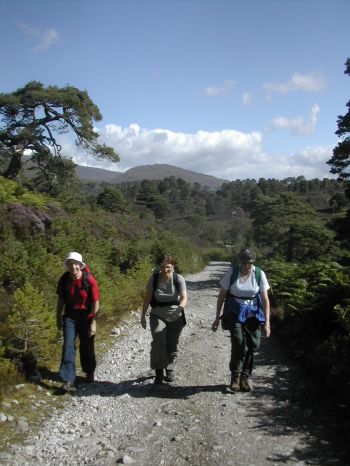
Photo credit: Scot Mountain Holidays
Hiking the Lairig Ghru is a challenge in itself which anyone can complete as a charity challenge. It is a well-known and clearly defined goal familiar to most Scottish hikers, though has less of a reputation south of the border. Some mountain rescue teams already offer the route as an organised challenge event. Please contact us if you are proposing to hike the Lairig Ghru to raise funds for a charity.
We can also offer the Lairig Ghru as a guided option which might be a good option if you are on your own as we are not able to combine self-guided groups for insurance reasons. Please phone: 01479 831 331 for full details or visit our contact us page.
We’re often asked when it is a good time to come to Scotland. For us every season has it’s advantages and perhaps disadvantages, depending on your point of view. There are definitely certain times of year which are better for hiking than others. There are also certain times of year when it is best to be in particular areas. If you’re a weather geek, you can find out for yourself which are statistically the best weeks to plan your trip by studying the “weather singularities”.
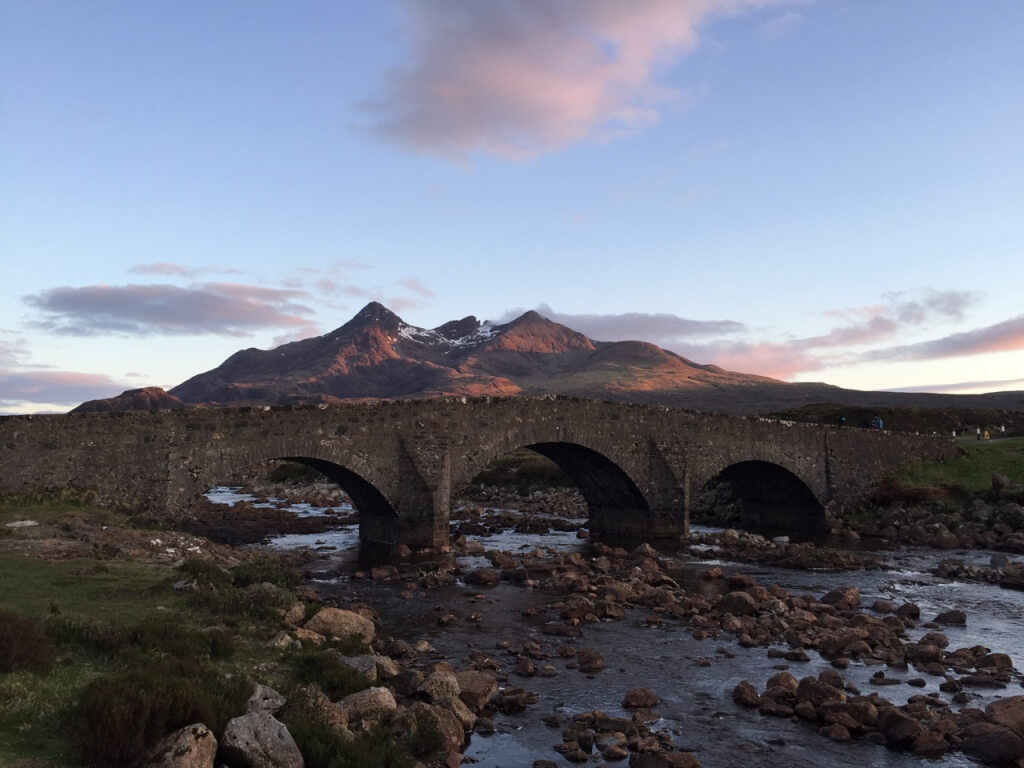
Sunset over Am Basteir from Sligachan on the Isle of Skye during the Skye Munros itinerary
Weather singularities are statistically proven times of year when the same weather tends to re-occur e.g. always dry that week. In fact, these have been noted so frequently in some cases that they even have traditional names like: “St. Luke’s Summer” or “Old Wives Summer”. Andy has studied the weather very closely and plans our west coast trips around the times of year when we are statistically likely to have the best conditions. This is why one of the most frequent comments we have as guests depart is: “Haven’t we been lucky with the weather?” Mind you, that might also be due to the fact that they come expecting to be rained on every day. Any day which is dry is considered to be a bonus!
You can choose by season which would be the best time of year to plan your trip. Whether it will rain or not, is not necessarily the only factor which would influence your decision. You may also want to consider what wildlife will be around or how long the day will be.
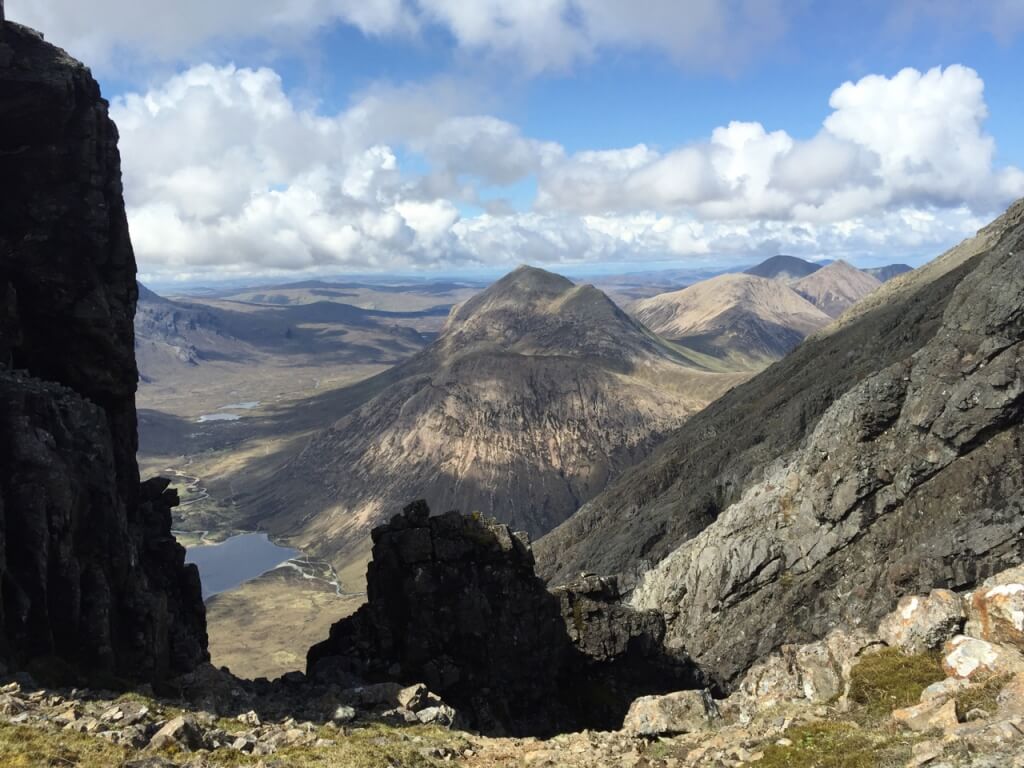
Spectacular views for the Cuillins on the Isle of Skye
The division for the Spring months may be surprising, but here in the Highlands of Scotland, Spring doesn’t really arrive until April. Skye is a wee bit more of a warmer climate than by our home base in the Cairngorms. Being closer to the sea, Spring can arrive earlier and the wildflowers will often start to put on an appearance in March. Our Spring months are more often than not April, May and June. Spring is an amazing time to visit Skye, in particular, as more often than not the dreaded midge has not awoken from her winter slumbers; the days are long and the weather is frequently dry and more often than not, sunny.
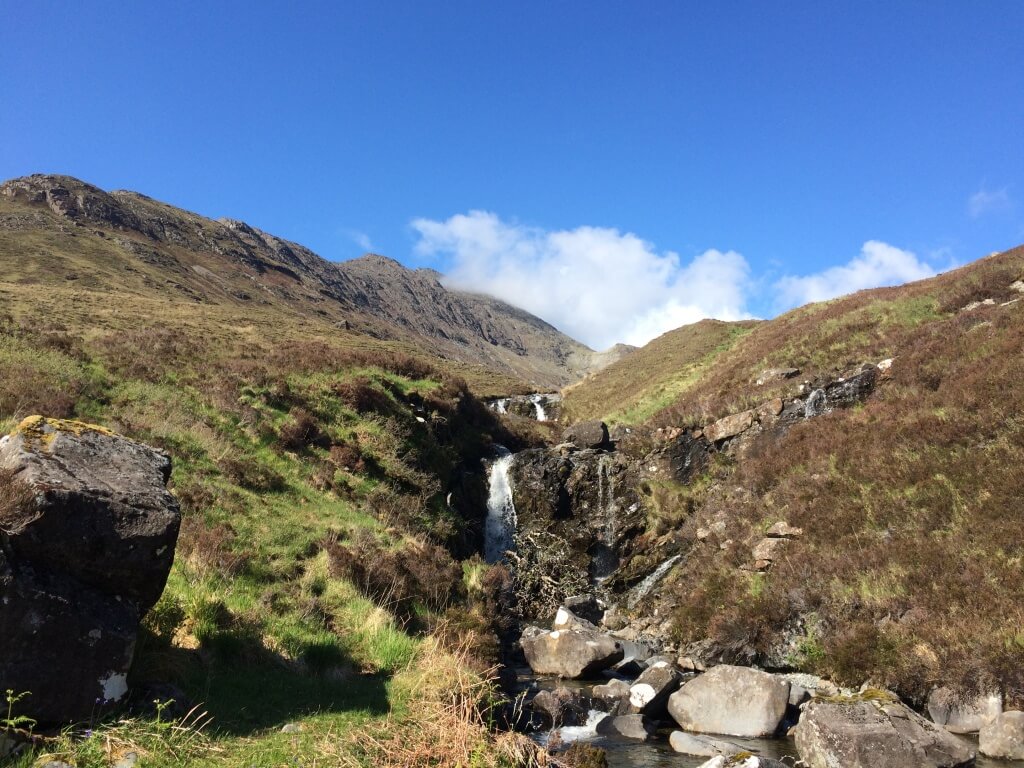
It’s hard hiking the Munros on Skye but all the views make is well-worth it in blue sky weather.
The seabirds, like the gannets and guillemots’ start to return to the cliffs surrounding Skye in Spring. Sea Eagles and Golden Eagles nest on Skye. The Sea Eagles tend to lay their eggs early in the Spring with a 6 week incubation period. The chicks could well be hatching around the time we will be on Skye in May. Once the chicks hatch the Sea Eagles and Golden Eagles are very active hunting for food to feed them. Spring is a very good time to spot the eagles.
Baby lambs will be playing in the fields. Skye is certainly a good place to spot lambs. Plenty of sheep in the lower fields of Skye as well as a thriving wood industry producing both yarn and cloth.
Another advantage of Spring, particularly May, is that the daylight hours are so long. Though we’re not quite at the longest day (mid-June), you can still be out at 10pm without the need for a headtorch.
Seeing the sun still up at 10pm and 3am or earlier is something which astounds most tourists. Be sure to make sure your accommodation has good curtains though if you’d rather have a good night’s sleep. If the sun is out, it can be glaring at 4am and most of us don’t appreciate that when we’d rather be sleeping.
July is the month to see the best of the orchids.
In August, there are plenty of wading birds to be found on the shores of the lochs and the heather is out in full bloom turning the sides of the hills purple. It’s also a really good time to spot whales, dolphins and porpoises.
The biggest disadvantage of visiting Skye in the height of summer is the sheer volume of tourists with the same idea. It can be extremely difficult to find accommodation and the road’s there just aren’t built for the volume of traffic.
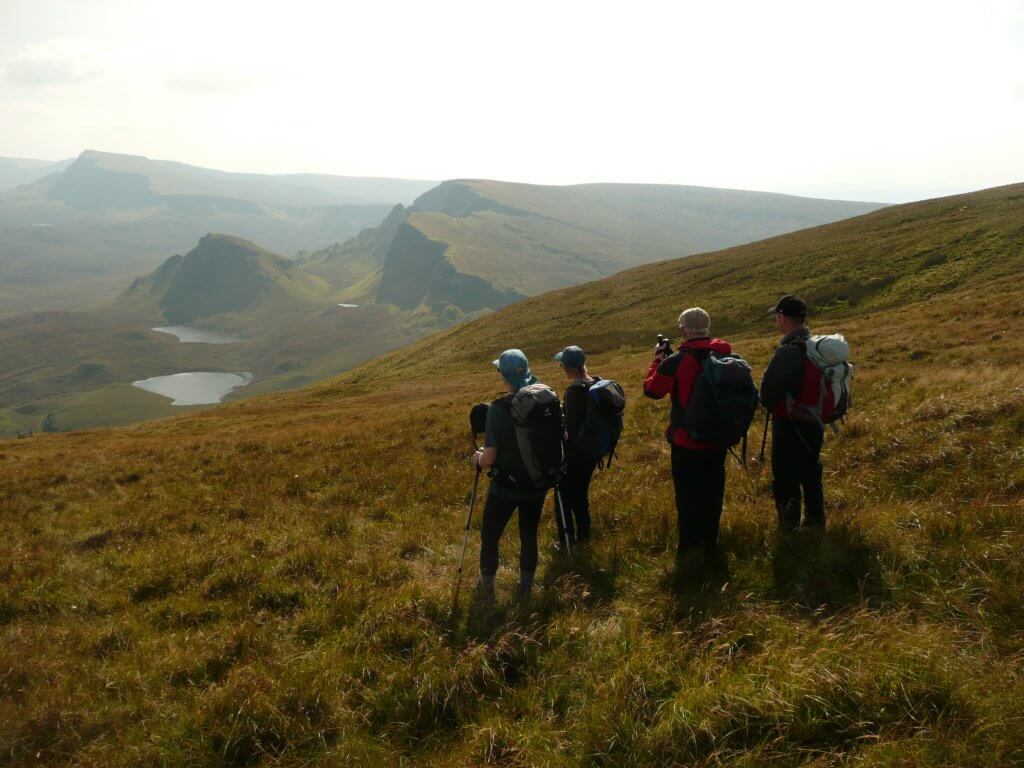
The Trotternish ridge on the isle of Skye
October is far and away the best time to spot the northern lights from Skye and November is the time to see the fireworks display at Dunvegan Castle. The display includes setting fire to a Viking longship. The difficulty for hikers though is that the sun sets before 5pm meaning that it is difficult, but not impossible, to complete a full mountain day in the light. The plus side though is that both sun rise and sun set can be glorious. It’s much easier to spot a good sunrise when it takes place around 7am rather than in the early hours of the morning.
December is an extremely good time to spot the sea eagles who are in the midst of their mating rituals now. The eagles will be soaring in the sky displaying and getting ready to pair up. Winter can also be a very good time to spot red deer who tend to come lower down the hills and can be spotted at the roadside in search of food. It’s also the best time to look for otters.
We’ve picked a prime week in May to visit Skye and pick off the Cuillin Munros. The guided trip will be fully inclusive of accommodation and meals as well as transport to the walks and pick up from Inverness airport, Fort William and Aviemore station depending on your travel arrangements.
We also have our Superlative Skye trip available to groups of 4 or more people. It’s not currently scheduled and our calendar for 2017 is rapidly filling up so do get in touch soon if you’re hoping for us to run this itinerary. We could even make a plan for 2018!
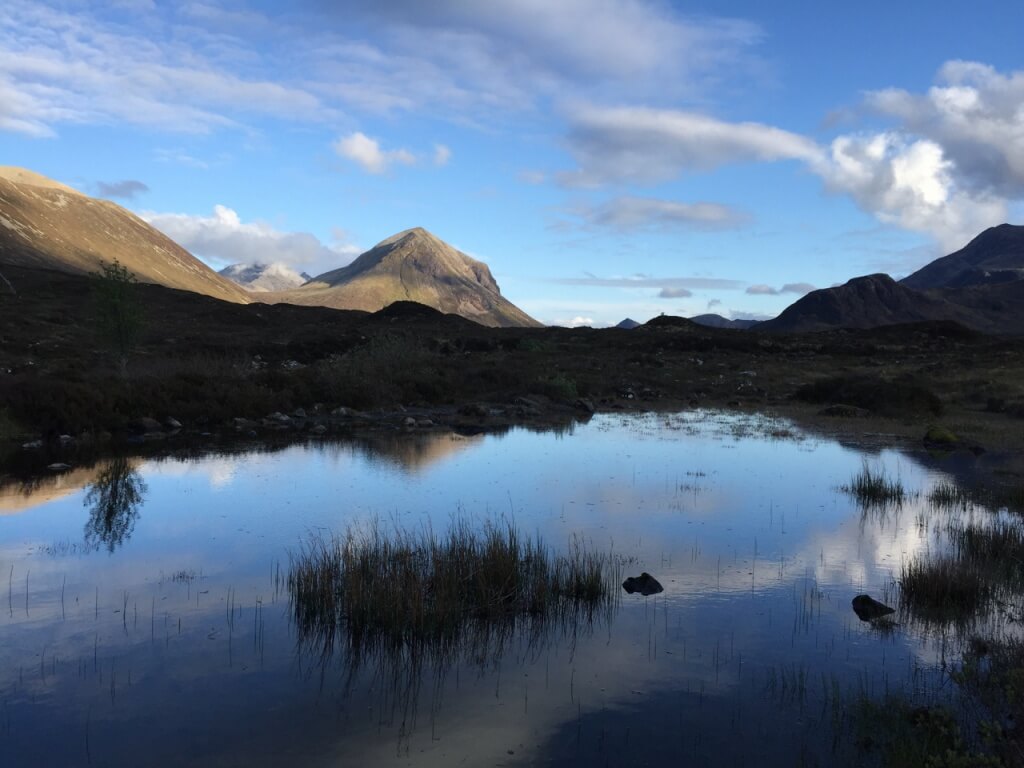
Perfect weather in May 2017 when our group picked off all the Munro summits.
Making the most of your time on Skye
When to visit the Glendale area of Skye
The weather statistics for Glendale
WOW Scotland: the best time of year to visit the Highlands of Scotland
What a week of Guided winter walking in Scotland – almost 4 seasons in one week! From full whiteout blizzard to stunning views for miles from the summit of Braeriach, enhanced by a broken spectre with 2 silhouettes in the middle.
From conditions like this:
To glorious views like this:
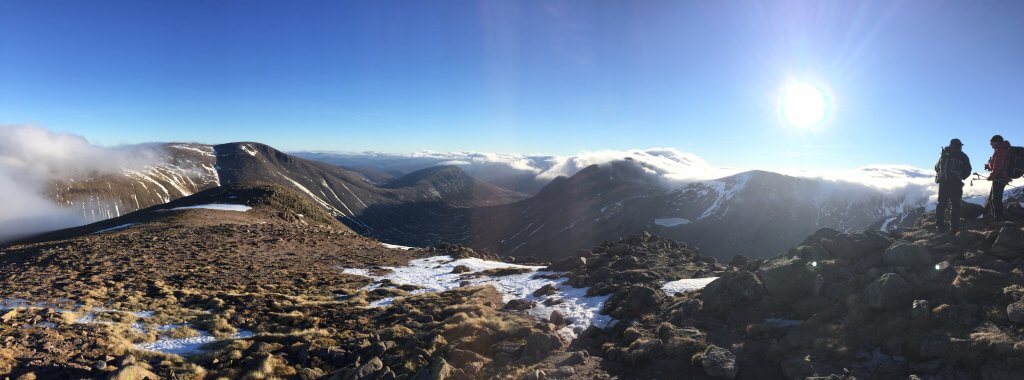 Stunning views to compensate for the lack of snow cover in the Cairngorms (courtesy of Claire Grogan)
Stunning views to compensate for the lack of snow cover in the Cairngorms (courtesy of Claire Grogan)
The weekend at the beginning of the trip offered the worst of the weather, but unfortunately if you have to get back to work … maybe next time those who couldn’t stay on will be treated to views similar to those from Braeriach at the end of the week.
“Thank you again for a very enjoyable week. Andy’s knowledge of the mountains and of the geology, flora and fauna, together with the welcoming and homely atmosphere and Rebecca’s cooking makes for a great combination”
These are just a selection of some of the points which have made the week so memorable and will hopefully serve as talking points when everyone gets home.
Group:
included
– a diverse group of individuals (including one couple) united by a common interest.
We saw a vole and it didn’t just pop out and disappear; it stayed and snuffled around searching for food. We have a really good view of it.
Sightings of ptarmigan became quite common place as the week went on. The first was exciting but by the end of the week, we’d had at least 5 sightings. Ptarmigan sightings were exciting for one of our guests whose young grandson (under 10 years old) is a keen birdwatcher, so it was something he could share with him.
We spotted golden eagle and mountain hare in the white winter plumage.
Many a hiker would love to be treated to a broken spectre. It adds a certain “je ne sais quoi” to the day and provides a talking point. Everyone wanted to see the pics (and it certainly proved popular on our social media.
https://www.instagram.com/p/BPhU-QVhzFg/?taken-by=scotmountainholidays
Panoramic photos courtesy of Claire Grogan
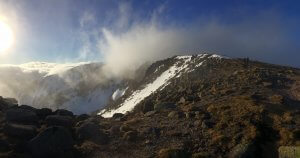 Stunning winter views in the Cairngorms highlighted by a slight wisp of cloud to add character to the picture
Stunning winter views in the Cairngorms highlighted by a slight wisp of cloud to add character to the picture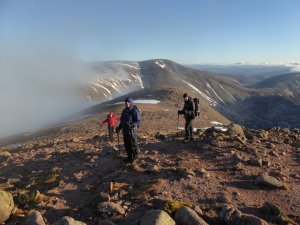 Not so wintry in the Cairngorms but still enjoying the company and repartee as the group ascends the ridges in the Cairngorms
Not so wintry in the Cairngorms but still enjoying the company and repartee as the group ascends the ridges in the Cairngorms
Check out our Facebook album for a fuller collection of the photos taken during our trip.
Lentil loaf – a great vegetarian recipe to have up your sleeve for parties/dinners with friends.
Other food: Recipes going live shortly:
Beetroot brownies
Banana and fruit loaf pudding
Grasmere gingerbread
Raspberry and pine nut bars
Tear and share tomato and cheese bread
A great group who enjoyed the variety of walking options during the week and did perhaps feel that they accomplished more in the week than they would have done without Andy’s guidance.
Travel experiences play one of the most important roles in why so many of us continue to explore the world. Although this age of technology allows us to document almost every part of our day, nothing compares with experiencing something firsthand.
Visiting somewhere you’re not familiar with already means you have an open mind. But exposing yourself to the unexpected when travelling often allows you to broaden your mind so much further. This includes with culture, religion, food and people. Having an open mind and being willing to dive head first into an experience will make travel experiences exceptional.
One of the best things you can do when travelling is get out of your comfort zone. Pushing yourself mentally, physically and emotional often yields the most wonderful of rewards. Scott Mountain Holidays will stretch your boundaries through both tailor made and structured group trips. But not to worry. Your boundaries may be stretched, but with Andy as your guide you’ll be well looked after.
Creating a special travel experience means you need to be willing to embrace interacting with locals, nature and culture alike. This will provide you with a well-rounded experience of a place and the opportunity to interact with likeminded individuals from across the world. Completing a tour with Scot Mountain Holidays will also allow you the rare opportunity to really embrace Scotland.
Photos and videos are such a wonderful way to capture the very best moments of a trip. However travelling is also a wonderful opportunity to take a step away from technology. When travelling, you can be present in the moment rather than experience it through the lens of your phone. So make your travel experience extra special and take the opportunity to really appreciate the place you’re in and what you’re exposed to. Scot Mountain Holidays hiking and walking trips allow you the chance to do this with plenty of opportunities to whip out your camera.
Scot Mountain Holidays is all about the experiences. Participate in walking, hiking or mountain biking holidays in a stunning Scotland, and you’ll go home with travel memories and experiences that will stay with you forever.
A taster of winter skills, but the only way to really learn how to ice axe arrest is to do it yourself under the guidance of a winter mountain leader or other qualified instructor. Imagine taking a tablet or smartphone out in the snow to try and teach yourself … pretty much a lost cause at the end of the day and you’d be terrified of smashing your technology to pieces. Bit the bullet and book a course.
We found this video on YouTube, produced by the MCofS. Here Roger Wild introduces ice axe arrest and explains the basics which you’d learn on the hill with Andy (lead instructor with Scot Mountain Holidays). If you’re comtemplating a winter skills weekend, bear in mind that this is one of the core skills you’ll be learning, which many people have heard about before they book a skills weekend; however, as Roger Wild says: there’s a lot more to the full range of skills to keep you safe in winter and you should consider ice axe arrest to be the last in a series of skills aimed at preventing a sliding fall.
Check out our Top Ten Winter Skills tips: https://scotmountainholidays.com/blog/top-10-winter-skills-tips/
Guided walking holidays in the Cairngorms National Park are our speciality. The one which was most popular in 2014 was Complete Cairngorms. It has attracted bookings from France, Germany, Norway, Denmark, Russia … and only goes to show that the National Park designation has its own attraction. Guests from all over the world are choosing to spend their hard earned vacation on a visit to the Cairngorms.

Photo Caption: Exploring the Cairngorms on foot
Photo Credit: Scot Mountain Holidays
This trip is a fully guided hiking vacation in Britain’s largest national park. National Park designation has attracted a lot more visitors over the past 10 years than previously when though the British were, to some degree, award of the Cairngorm mountain range and the Cairngorm Ski Centre; even they had no idea of the extent and breadth of the Park itself.
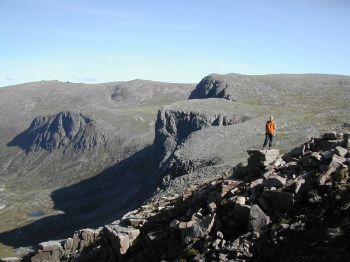
Photo Caption: Loch A’an – hidden deep in the Cairngorms this is a viewpoint you can only reach on foot.
Photo Credit: Scot Mountain Holidays
The Complete Cairngorms holiday takes place over a full week, but does have a rest day in the middle for clients to put up their weary feet or explore for a bit of retail therapy or souvenir shopping – if you’re lucky the trip might coincide with the summer sales in one of Aviemore’s multitude of hiking gear shops.
Essentially this is a hiking vacation with some culture, folklore and wildlife to enhance the hiking experience. A visit to the Cairngorms National Park would not be complete unless it took in the whole of the park. On this trip guests visit Glenlivet for the whisky and smuggler experience; Royal Deeside to walk on the Balmoral Estate (if the timing is right we may also visit the castle, though in August we may need to go to Braemar Castle instead – home of the largest Cairngorm Stone discovered) August is the Queen’s annual vacation which she spends at Balmoral Castle, so the castle is not open then; and of course we visit Cairngorm mountain itself and the surrounding estates of Glenfeshie & Rothiemurchus, with its wildlife hide, where we hope to see the elusive pine martens.
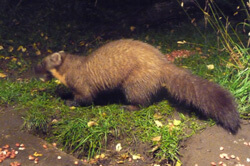
One of the rate nocturnal pine martens viewed from the Wildlife hide used by BBC Spring Watch programme
Photo caption: Pine Marten at the Speyside Wildlife hide in the Cairngorms
Photo credit: Scot Mountain Holidays
This holiday has attracted visitors from: Germany, France, the Netherlands, Denmark, Russia, and Finland which only goes to show how much the National Park designation attracts visitors in its own right.
Further guided walking holidays
Information about Royal Deeside: http://visitroyaldeeside.com/
Official Cairngorms National Park website: http://cairngorms.co.uk/
Visit Cairngorms website: http://visitcairngorms.com
Stunning remote wilderness scenery
Scot Mountain Holidays put a new trip together this year (2013): an exploration of Harris and Lewis. As usual, this was very well planned and the logistics carefully thought out. We departed their base at Boat of Garten, picking up clients at Aviemore and Inverness stations, before driving to Ullapool. There we boarded the ferry to Stornaway, for which we arrived in plenty of time. On the crossing, there was time to admire the receding scenery of the northern mainland mountains and the approaching islands silhouetted against the setting sun, as well as to enjoy a meal on board. From Stornaway we then took an interesting drive down to Tarbert, our base for the week in some well-equipped holiday cottages.
Andy had prepared a very varied itinerary, a pleasant blend of hill and coastal walking, with visits to many places of interest. As always, he was a mine of information on the geology, the geography, the flora and fauna and especially the bird life. Among other species, we saw lapwings, golden plover, cormorants, gannets fishing, a Great Northern Diver and, of course, at least half a dozen eagles ….
Beautiful white sand beaches of the Hebrides
On the midweek ‘rest’ day, we had the opportunity for a scenic drive around south Harris. We visited a prehistoric standing stone and also a visitor centre. I was intrigued to discover why Lewis and Harris have separate names, even though they are one landmass. In former times, there were no roads through the hills forming a barrier between the two, so all the traffic had to be by boat around the coast, effectively making them separate islands!
We also discovered that the island has become something of a haven for artists and photographers. There are quite a few studios dotted around, often with hospitable cafes! For the botanist, the coastal scenery is much enhanced by the ‘machair’ wild flower meadows.
There is much of interest too for the historian: the famous prehistoric standing stones at Callanish, an Iron Age ‘broch’ (chieftain’s house) in a well preserved state, and more recently the ruins, mainly just a chimney, of a former whaling station; there is even a present-day indication of long-established customs in that many people still cut and dry peat for fuel!
I have so far not mentioned the hillwalking, which can be very challenging even though the hills are not of the highest, due to the dearth of paths and tracks, giving one a real feeling of pioneering. And:
“These mountains don’t know they’re 2000 feet high, from the rock
Of the summit, where the clouds cling, down to the lap of the loch.
In their mist shawls they crouch, silent, by the side of the glen,
Indifferent to Man and the measures of men.”
Even dedicated ‘Munro-baggers’ would find much to enjoy here, since the terrain is very rugged, the ascents are often steep and one usually starts from sea level. Coupled with the remoteness of the island, this means that we encountered few other walkers during the week.
Probably my favourite ascent was that of Tiorga Mor. After an interesting walk up the valley track, we turned on to the mountain shoulder. This gave some superb walking up ‘boiler-plate’ slabs, with occasional delectable little scrambles, to the summit ridge.
From the top, we had extensive views over many islands, including Taransay (of TV’s ‘Castaway’ fame) and even St Kilda on the far horizon. Looking down on the white sand beaches and the turquoise sea-shallows it made me think of Greece, another country which I love. From the summit, we turned north to traverse Tiorga Beag and eventually started to get increasingly dramatic profile views of the north end of Sron Uladale; this is of particular interest to those of a rock-climbing bent, as it is the largest crag overhang in Britain. Some brave soul has even jumped off the top with a parachute!
Complementing Andy’s expert and informative guiding was the magnificent cuisine produced by Rebecca. After a substantial breakfast, we had a wide choice of fillings for our sandwiches. We assembled our own lunches with the fresh home-baked bread. On our return to base, we enjoyed the famous ‘Cake-o-Clock’: refreshing tea and home-made cake, before the excellent evening meals.
Apart from the main scenic delights, there were other intriguing little sights for those of a whimsical turn of mind:
a well-maintained tennis court miles down a single-track dead-end road, probably the most remote such facility in Britain, if not the world; and an optimistic ‘For Sale’ sign in front of a derelict cottage
On the return ferry there was of course sadness at leaving this unique place, but also compensation in the approaching views of the northern Scottish mountains across a sun-smeared sea.
Overall, this was a very interesting and enjoyable trip, underlining the Scot Mountain Holidays slogan: “A Sense of Place and Belonging” It is an expedition well worth repeating.
Mick Wansborough June 2013
All content © Copyright Scot Mountain Holidays 2025
Responsive web design by Summit Web Solutions